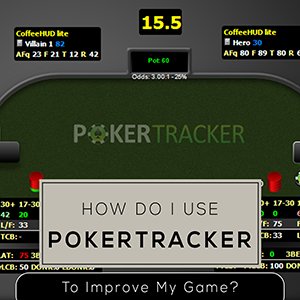Poker HUD Explained
A Poker HUD (heads-up display) is a tool in poker that will be an overlay to the table that will help to show the opponent’s tendencies. It is compiled from the hand histories that you have with the given opponent by the tracking program that you are using. A player’s HUD can be customized in any number of ways, based on the type of games they play and also for any given street of play.
Poker Stats Defined
The most common stats for a basic HUD are the following and are used mainly for preflop play:
VPIP – Voluntarily put chips in pot (the % of hands that an opponent is playing)
PFR – Preflop raise %
3B – Three bet %
F3B – % that a player folds to a 3-bet
BB or M – stack size, either in big blinds or times around the table they have left before blinding out
CB – Continuation bet % (how often a player bets the flop when they are the last preflop raiser)
FCB – % that a player folds to a continuation bet
STL – steal % from CO/BU/SB (this can also be broken down to the individual positions if wanted)
FSTL – % that a player folds to a late position steal attempt
Number of hands – I have this in a bold color so that this stands out
These values help us to categorize the opponent, so that we then know the correct course of actions we want to take against a given type of player.
Poker HUD Stats Relevancy
An example: A player that has a high VPIP and low PFR is a loose passive player, so when they actually raise preflop, we need to have a real hand to play back at them (they’re most likely not bluffing) and also this type of opponent is one that we don’t want to bluff or try to steal from with junk (because they won’t fold).
Another example would be for a player with a very high CB number. They will bet too many flops, so we can then go for more check/raises or floats against them on the flop when we have a made hand, as they’re more likely to bet than check.
Also, if we’re in late position and the players behind us have high FSTL numbers, these players overfold, so they’re great targets to try to steal against.
There are also some large errors that many players make when using a HUD, so here are ones that you want to watch out for and avoid.
First, in order to get an accurate picture of how an opp is playing, we need to have a sizeable quantity of hands. Lots of players will look at their HUD and say, well, this player folds to c-bets 80% of the time, so I can easily follow thru and bluff… but then when you look at how many hands they have, it’s 4 of 5 or 8 out of 10… well, the opp just may be on a run of lower hands that missed, so a statement like this may not be viable, unless the quantity of opportunities is a sizeable number.
The next is that if you look at a player’s tendencies preflop, that’s not necessarily how they will react postflop. For example, a loose passive player could be of the type that they want to see every flop, but then play fit or fold postflop. Well, while we wouldn’t want to bluff the player preflop, they may be a perfect candidate for it postflop. Some opps may also always call a flop bet (so we wouldn’t want to bluff there) but may fold too much to a second barrel on the turn.
HUD’s can also be an invaluable tool for looking at not just the opponent’s play, but also our own play. If we see throughout a session or tournament that our %’s are out of line on a given stat, we can then use that to our advantage. Say for example, we have faced ten c-bets and have folded on all of them. Well, the opps may look and say incorrectly… well, this player folds to all c-bets so I can try to steal one. Well, this could be a great spot to raise as a bluff or float and take the pot away later in the hand.
Poker HUD I Use
Whenever I’m streaming, www.twitch.tv/jwk24, if I’m playing on any site that I can use PokerTracker4, while I may not have the HUD showing on stream, I do have it up and running. I don’t always show it because sometimes it can clutter up the table and make it harder for someone watching the stream, to follow, but I absolutely state on stream when I’m making a play in any based on something I pick up on either from the HUD or my notes on a given opp, to help explain why I’m making a given play in a given situation. This can lead to strategy questions from the audience, which then can turn into a great strategy discussion, which I’m happy to be a part of on stream, as I’m regularly involved in these discussions due to my work for PokerStars School. These types of discussions are what can keep viewers engaged and keep them coming back to your stream.

